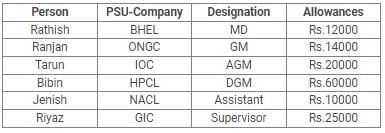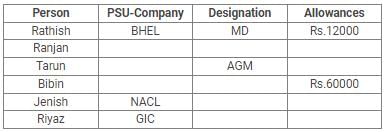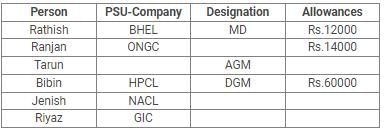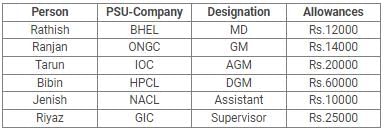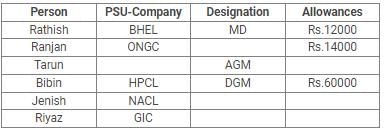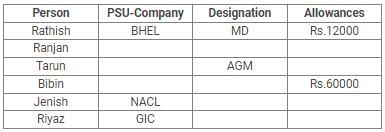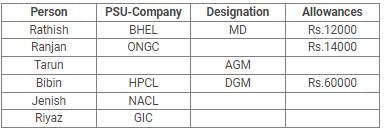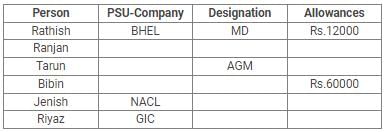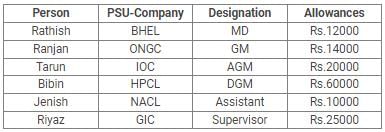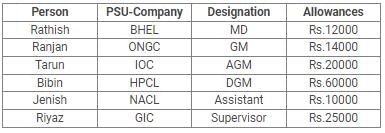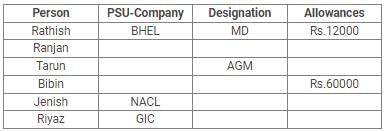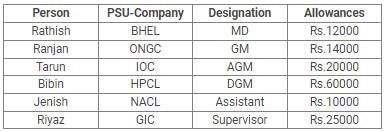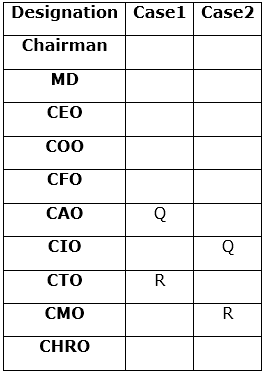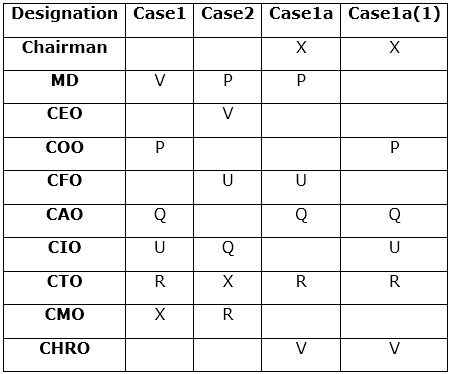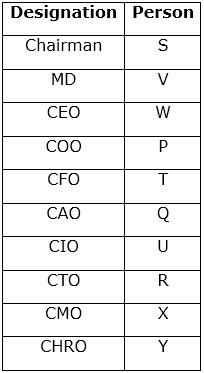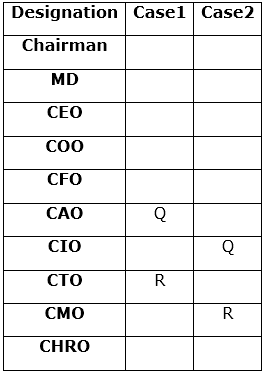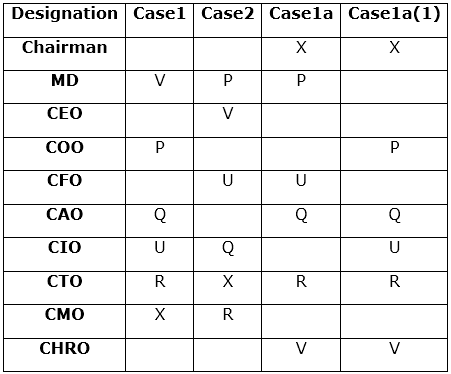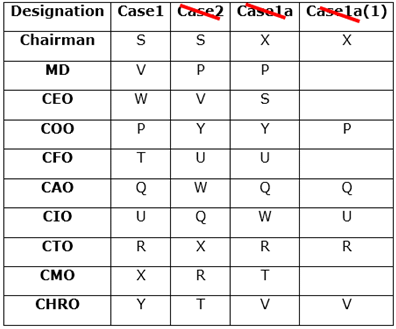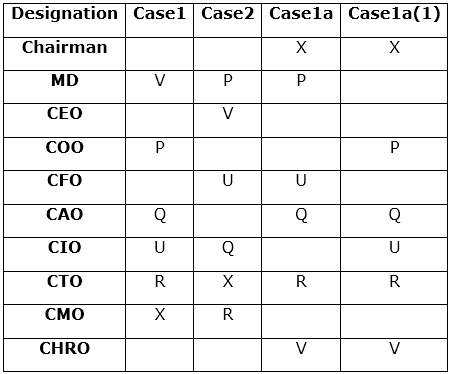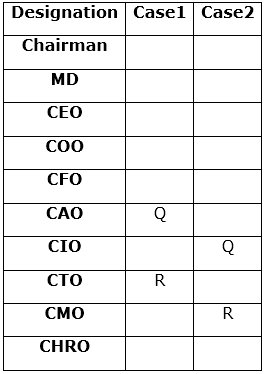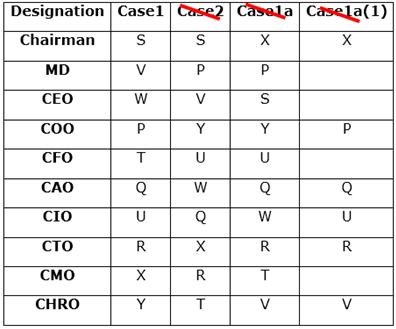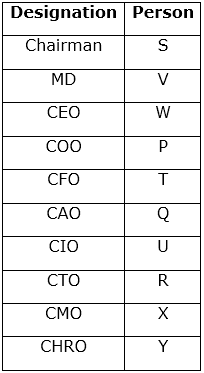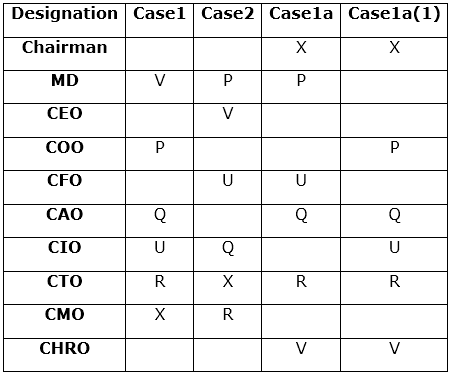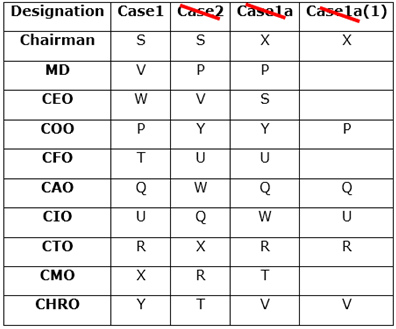MCQ Test: Designation Puzzle - 2 - Bank Exams MCQ
15 Questions MCQ Test Reasoning Aptitude for Competitive Examinations - MCQ Test: Designation Puzzle - 2
Directions: Read the given information carefully and answer the questions given below.
Six persons namely Rathish, Ranjan, Tarun, Bibin, Jenish and Riyaz are working in different public-sector undertakings among BHEL, ONGC, IOC, HPCL, NACL and GIC but not necessarily in the same order. They all are at different designations like MD, GM, AGM, DGM, Assistant and Supervisor but not necessarily in the same order. They all get special allowances for their efficient work among Rs.12000, Rs.14000, Rs.20000, Rs.60000, Rs.10000 and Rs.25000 but not necessarily in the same order. Rathish works in BHEL as MD and he gets Rs.12000. Riyaz works in GIC. Tarun is an AGM. Bibin gets Rs.60000. Jenish works in NACL. The person who is working in ONGC gets Rs.14000. The one who works in HPCL is DGM. The Supervisor gets Rs.25000 but he is not Jenish. Ranjan neither works in IOC nor works in HPCL. The Assistant gets Rs.10000.
Q. Which among the following is GM?
Six persons namely Rathish, Ranjan, Tarun, Bibin, Jenish and Riyaz are working in different public-sector undertakings among BHEL, ONGC, IOC, HPCL, NACL and GIC but not necessarily in the same order. They all are at different designations like MD, GM, AGM, DGM, Assistant and Supervisor but not necessarily in the same order. They all get special allowances for their efficient work among Rs.12000, Rs.14000, Rs.20000, Rs.60000, Rs.10000 and Rs.25000 but not necessarily in the same order. Rathish works in BHEL as MD and he gets Rs.12000. Riyaz works in GIC. Tarun is an AGM. Bibin gets Rs.60000. Jenish works in NACL. The person who is working in ONGC gets Rs.14000. The one who works in HPCL is DGM. The Supervisor gets Rs.25000 but he is not Jenish. Ranjan neither works in IOC nor works in HPCL. The Assistant gets Rs.10000.
Directions: Read the given information carefully and answer the questions given below.
Six persons namely Rathish, Ranjan, Tarun, Bibin, Jenish and Riyaz are working in different public-sector undertakings among BHEL, ONGC, IOC, HPCL, NACL and GIC but not necessarily in the same order. They all are at different designations like MD, GM, AGM, DGM, Assistant and Supervisor but not necessarily in the same order. They all get special allowances for their efficient work among Rs.12000, Rs.14000, Rs.20000, Rs.60000, Rs.10000 and Rs.25000 but not necessarily in the same order. Rathish works in BHEL as MD and he gets Rs.12000. Riyaz works in GIC. Tarun is an AGM. Bibin gets Rs.60000. Jenish works in NACL. The person who is working in ONGC gets Rs.14000. The one who works in HPCL is DGM. The Supervisor gets Rs.25000 but he is not Jenish. Ranjan neither works in IOC nor works in HPCL. The Assistant gets Rs.10000.
Q. How much amount is received by Tarun?
Six persons namely Rathish, Ranjan, Tarun, Bibin, Jenish and Riyaz are working in different public-sector undertakings among BHEL, ONGC, IOC, HPCL, NACL and GIC but not necessarily in the same order. They all are at different designations like MD, GM, AGM, DGM, Assistant and Supervisor but not necessarily in the same order. They all get special allowances for their efficient work among Rs.12000, Rs.14000, Rs.20000, Rs.60000, Rs.10000 and Rs.25000 but not necessarily in the same order. Rathish works in BHEL as MD and he gets Rs.12000. Riyaz works in GIC. Tarun is an AGM. Bibin gets Rs.60000. Jenish works in NACL. The person who is working in ONGC gets Rs.14000. The one who works in HPCL is DGM. The Supervisor gets Rs.25000 but he is not Jenish. Ranjan neither works in IOC nor works in HPCL. The Assistant gets Rs.10000.
Directions: Read the given information carefully and answer the questions given below.
Six persons namely Rathish, Ranjan, Tarun, Bibin, Jenish and Riyaz are working in different public-sector undertakings among BHEL, ONGC, IOC, HPCL, NACL and GIC but not necessarily in the same order. They all are at different designations like MD, GM, AGM, DGM, Assistant and Supervisor but not necessarily in the same order. They all get special allowances for their efficient work among Rs.12000, Rs.14000, Rs.20000, Rs.60000, Rs.10000 and Rs.25000 but not necessarily in the same order. Rathish works in BHEL as MD and he gets Rs.12000. Riyaz works in GIC. Tarun is an AGM. Bibin gets Rs.60000. Jenish works in NACL. The person who is working in ONGC gets Rs.14000. The one who works in HPCL is DGM. The Supervisor gets Rs.25000 but he is not Jenish. Ranjan neither works in IOC nor works in HPCL. The Assistant gets Rs.10000.
Q. Who among the following works in IOC?
Six persons namely Rathish, Ranjan, Tarun, Bibin, Jenish and Riyaz are working in different public-sector undertakings among BHEL, ONGC, IOC, HPCL, NACL and GIC but not necessarily in the same order. They all are at different designations like MD, GM, AGM, DGM, Assistant and Supervisor but not necessarily in the same order. They all get special allowances for their efficient work among Rs.12000, Rs.14000, Rs.20000, Rs.60000, Rs.10000 and Rs.25000 but not necessarily in the same order. Rathish works in BHEL as MD and he gets Rs.12000. Riyaz works in GIC. Tarun is an AGM. Bibin gets Rs.60000. Jenish works in NACL. The person who is working in ONGC gets Rs.14000. The one who works in HPCL is DGM. The Supervisor gets Rs.25000 but he is not Jenish. Ranjan neither works in IOC nor works in HPCL. The Assistant gets Rs.10000.
Directions: Read the given information carefully and answer the questions given below.
Six persons namely Rathish, Ranjan, Tarun, Bibin, Jenish and Riyaz are working in different public-sector undertakings among BHEL, ONGC, IOC, HPCL, NACL and GIC but not necessarily in the same order. They all are at different designations like MD, GM, AGM, DGM, Assistant and Supervisor but not necessarily in the same order. They all get special allowances for their efficient work among Rs.12000, Rs.14000, Rs.20000, Rs.60000, Rs.10000 and Rs.25000 but not necessarily in the same order. Rathish works in BHEL as MD and he gets Rs.12000. Riyaz works in GIC. Tarun is an AGM. Bibin gets Rs.60000. Jenish works in NACL. The person who is working in ONGC gets Rs.14000. The one who works in HPCL is DGM. The Supervisor gets Rs.25000 but he is not Jenish. Ranjan neither works in IOC nor works in HPCL. The Assistant gets Rs.10000.
Q. Which of the following is not correct?
Directions: Read the given information carefully and answer the questions given below.
Six persons namely Rathish, Ranjan, Tarun, Bibin, Jenish and Riyaz are working in different public-sector undertakings among BHEL, ONGC, IOC, HPCL, NACL and GIC but not necessarily in the same order. They all are at different designations like MD, GM, AGM, DGM, Assistant and Supervisor but not necessarily in the same order. They all get special allowances for their efficient work among Rs.12000, Rs.14000, Rs.20000, Rs.60000, Rs.10000 and Rs.25000 but not necessarily in the same order. Rathish works in BHEL as MD and he gets Rs.12000. Riyaz works in GIC. Tarun is an AGM. Bibin gets Rs.60000. Jenish works in NACL. The person who is working in ONGC gets Rs.14000. The one who works in HPCL is DGM. The Supervisor gets Rs.25000 but he is not Jenish. Ranjan neither works in IOC nor works in HPCL. The Assistant gets Rs.10000.
Q. Which of the following persons gets Rs.20000 for special allowance?
Study the following information carefully and answer the below questions
Eight persons – E, F, G, H, I, J, K and L are working in three different Banks viz. Canara Bank, Vijaya Bank and DenaBank at different posts - Probationary Officer (PO) and Clerk. In the Dena Bank only Probationary Officer(PO)post is available. They are all having different ages. The age of the persons who are Probationary officers is a composite number and the ages of the persons who are clerk is a Prime number. Each person’s age is between 21 and 75. Minimum one and maximum of two persons are at each post in each Bank. All the above information is not necessarily in the same order.
Note: If it is given that the person who is a Clerk or a Probationary officer works with person X or the one whose age is 72 then it indicates that both the persons work in the same Bank but not necessarily at the same post.
G works in Canara bank but not with J. J works with the one whose age is 69 years but not in Dena bank. F is 45 years old and works along with H but not in Vijaya bank. G is not working as a Clerk. J who is not a Probationary Officer and is the youngest person in the group whose age is not more than 27. E doesn’t work in the Canara bank but works with the one whose age is 53 years. Age of E is 24 years more than the age of F. E’s age is 15 years more than the sum of the ages of L and J. I and K Work in different banks but works at the same post. K is elder than I. The one who works with G has 16 years more than L. There are equal numbers of Probationary Officers and Clerks. The difference between the ages of K and I is twice the difference between the ages of G and E who is younger than G. The age of H is 7 years less than the age of E.
Q. What is the sum of the ages of the persons who work in the Vijaya Bank?
Study the following information carefully and answer the below questions
Eight persons – E, F, G, H, I, J, K and L are working in three different Banks viz. Canara Bank, Vijaya Bank and DenaBank at different posts - Probationary Officer (PO) and Clerk. In the Dena Bank only Probationary Officer(PO)post is available. They are all having different ages. The age of the persons who are Probationary officers is a composite number and the ages of the persons who are clerk is a Prime number. Each person’s age is between 21 and 75. Minimum one and maximum of two persons are at each post in each Bank. All the above information is not necessarily in the same order.
Note: If it is given that the person who is a Clerk or a Probationary officer works with person X or the one whose age is 72 then it indicates that both the persons work in the same Bank but not necessarily at the same post.
G works in Canara bank but not with J. J works with the one whose age is 69 years but not in Dena bank. F is 45 years old and works along with H but not in Vijaya bank. G is not working as a Clerk. J who is not a Probationary Officer and is the youngest person in the group whose age is not more than 27. E doesn’t work in the Canara bank but works with the one whose age is 53 years. Age of E is 24 years more than the age of F. E’s age is 15 years more than the sum of the ages of L and J. I and K Work in different banks but works at the same post. K is elder than I. The one who works with G has 16 years more than L. There are equal numbers of Probationary Officers and Clerks. The difference between the ages of K and I is twice the difference between the ages of G and E who is younger than G. The age of H is 7 years less than the age of E.
Q. Which of the statement(s) is/are is true with respect to the final arrangement?
I. I works in the same bank as G.
II. The age of F is 45 years.
III. The age of L is 32 years.
Study the following information carefully and answer the below questions
Eight persons – E, F, G, H, I, J, K and L are working in three different Banks viz. Canara Bank, Vijaya Bank and DenaBank at different posts - Probationary Officer (PO) and Clerk. In the Dena Bank only Probationary Officer(PO)post is available. They are all having different ages. The age of the persons who are Probationary officers is a composite number and the ages of the persons who are clerk is a Prime number. Each person’s age is between 21 and 75. Minimum one and maximum of two persons are at each post in each Bank. All the above information is not necessarily in the same order.
Note: If it is given that the person who is a Clerk or a Probationary officer works with person X or the one whose age is 72 then it indicates that both the persons work in the same Bank but not necessarily at the same post.
G works in Canara bank but not with J. J works with the one whose age is 69 years but not in Dena bank. F is 45 years old and works along with H but not in Vijaya bank. G is not working as a Clerk. J who is not a Probationary Officer and is the youngest person in the group whose age is not more than 27. E doesn’t work in the Canara bank but works with the one whose age is 53 years. Age of E is 24 years more than the age of F. E’s age is 15 years more than the sum of the ages of L and J. I and K Work in different banks but works at the same post. K is elder than I. The one who works with G has 16 years more than L. There are equal numbers of Probationary Officers and Clerks. The difference between the ages of K and I is twice the difference between the ages of G and E who is younger than G. The age of H is 7 years less than the age of E.
Q. Who among the following person works in the Canara Bank?
Study the following information carefully and answer the below questions
Eight persons – E, F, G, H, I, J, K and L are working in three different Banks viz. Canara Bank, Vijaya Bank and DenaBank at different posts - Probationary Officer (PO) and Clerk. In the Dena Bank only Probationary Officer(PO)post is available. They are all having different ages. The age of the persons who are Probationary officers is a composite number and the ages of the persons who are clerk is a Prime number. Each person’s age is between 21 and 75. Minimum one and maximum of two persons are at each post in each Bank. All the above information is not necessarily in the same order.
Note: If it is given that the person who is a Clerk or a Probationary officer works with person X or the one whose age is 72 then it indicates that both the persons work in the same Bank but not necessarily at the same post.
G works in Canara bank but not with J. J works with the one whose age is 69 years but not in Dena bank. F is 45 years old and works along with H but not in Vijaya bank. G is not working as a Clerk. J who is not a Probationary Officer and is the youngest person in the group whose age is not more than 27. E doesn’t work in the Canara bank but works with the one whose age is 53 years. Age of E is 24 years more than the age of F. E’s age is 15 years more than the sum of the ages of L and J. I and K Work in different banks but works at the same post. K is elder than I. The one who works with G has 16 years more than L. There are equal numbers of Probationary Officers and Clerks. The difference between the ages of K and I is twice the difference between the ages of G and E who is younger than G. The age of H is 7 years less than the age of E.
Q. How many persons are elder than L?
Study the following information carefully and answer the below questions
Eight persons – E, F, G, H, I, J, K and L are working in three different Banks viz. Canara Bank, Vijaya Bank and DenaBank at different posts - Probationary Officer (PO) and Clerk. In the Dena Bank only Probationary Officer(PO)post is available. They are all having different ages. The age of the persons who are Probationary officers is a composite number and the ages of the persons who are clerk is a Prime number. Each person’s age is between 21 and 75. Minimum one and maximum of two persons are at each post in each Bank. All the above information is not necessarily in the same order.
Note: If it is given that the person who is a Clerk or a Probationary officer works with person X or the one whose age is 72 then it indicates that both the persons work in the same Bank but not necessarily at the same post.
G works in Canara bank but not with J. J works with the one whose age is 69 years but not in Dena bank. F is 45 years old and works along with H but not in Vijaya bank. G is not working as a Clerk. J who is not a Probationary Officer and is the youngest person in the group whose age is not more than 27. E doesn’t work in the Canara bank but works with the one whose age is 53 years. Age of E is 24 years more than the age of F. E’s age is 15 years more than the sum of the ages of L and J. I and K Work in different banks but works at the same post. K is elder than I. The one who works with G has 16 years more than L. There are equal numbers of Probationary Officers and Clerks. The difference between the ages of K and I is twice the difference between the ages of G and E who is younger than G. The age of H is 7 years less than the age of E.
Q. Who among the following person is not a Probationary Officer?
Study the following information carefully and answer the below questions
Ten persons- P, Q, R, S, T, U, V, W, X and Y are working in the company on different designations. The designations of the people in decreasing order are as follows Chairman, MD, CEO, COO, CFO, CAO, CIO, CTO, CMO, and CHRO where Chairman is the seniormost designated person and CHRO is the junior most designated person.
Q works three positions senior to the one who works immediately junior to R. More than four persons are senior to Q. Only three persons are designated between Q and V. The number of persons senior to V is the same as the number of persons junior to X. P works immediately junior to the one who works four positions senior to U. P neither works as CHRO nor CIO. The number of persons designated between P and Q is the same as the number of persons designated between R and Y. W is senior to T but not senior to S. T is designated as neither CMO nor CHRO.
Q. Who among the following person works as COO?
Study the following information carefully and answer the below questions
Ten persons- P, Q, R, S, T, U, V, W, X and Y are working in the company on different designations. The designations of the people in decreasing order are as follows Chairman, MD, CEO, COO, CFO, CAO, CIO, CTO, CMO, and CHRO where Chairman is the seniormost designated person and CHRO is the junior most designated person.
Q works three positions senior to the one who works immediately junior to R. More than four persons are senior to Q. Only three persons are designated between Q and V. The number of persons senior to V is the same as the number of persons junior to X. P works immediately junior to the one who works four positions senior to U. P neither works as CHRO nor CIO. The number of persons designated between P and Q is the same as the number of persons designated between R and Y. W is senior to T but not senior to S. T is designated as neither CMO nor CHRO.
Q. Four of the following five are alike in a certain way as per the given arrangement and thus form a group. Which one of the following does not belong to that group?
Study the following information carefully and answer the below questions
Ten persons- P, Q, R, S, T, U, V, W, X and Y are working in the company on different designations. The designations of the people in decreasing order are as follows Chairman, MD, CEO, COO, CFO, CAO, CIO, CTO, CMO, and CHRO where Chairman is the seniormost designated person and CHRO is the junior most designated person.
Q works three positions senior to the one who works immediately junior to R. More than four persons are senior to Q. Only three persons are designated between Q and V. The number of persons senior to V is the same as the number of persons junior to X. P works immediately junior to the one who works four positions senior to U. P neither works as CHRO nor CIO. The number of persons designated between P and Q is the same as the number of persons designated between R and Y. W is senior to T but not senior to S. T is designated as neither CMO nor CHRO.
Q. How many persons are senior to T?
Study the following information carefully and answer the below questions
Ten persons- P, Q, R, S, T, U, V, W, X and Y are working in the company on different designations. The designations of the people in decreasing order are as follows Chairman, MD, CEO, COO, CFO, CAO, CIO, CTO, CMO, and CHRO where Chairman is the seniormost designated person and CHRO is the junior most designated person.
Q works three positions senior to the one who works immediately junior to R. More than four persons are senior to Q. Only three persons are designated between Q and V. The number of persons senior to V is the same as the number of persons junior to X. P works immediately junior to the one who works four positions senior to U. P neither works as CHRO nor CIO. The number of persons designated between P and Q is the same as the number of persons designated between R and Y. W is senior to T but not senior to S. T is designated as neither CMO nor CHRO.
Q. In which of the following designation does R work?
Study the following information carefully and answer the below questions
Ten persons- P, Q, R, S, T, U, V, W, X and Y are working in the company on different designations. The designations of the people in decreasing order are as follows Chairman, MD, CEO, COO, CFO, CAO, CIO, CTO, CMO, and CHRO where Chairman is the seniormost designated person and CHRO is the junior most designated person.
Q works three positions senior to the one who works immediately junior to R. More than four persons are senior to Q. Only three persons are designated between Q and V. The number of persons senior to V is the same as the number of persons junior to X. P works immediately junior to the one who works four positions senior to U. P neither works as CHRO nor CIO. The number of persons designated between P and Q is the same as the number of persons designated between R and Y. W is senior to T but not senior to S. T is designated as neither CMO nor CHRO.
Q. Which of the following statement(s) is/are true with respect to the final arrangement?
I). Q is designated as CAO
II). Only two persons are designated between V and T
III). U works immediately junior to R
|
11 videos|20 docs|171 tests
|
|
11 videos|20 docs|171 tests
|


